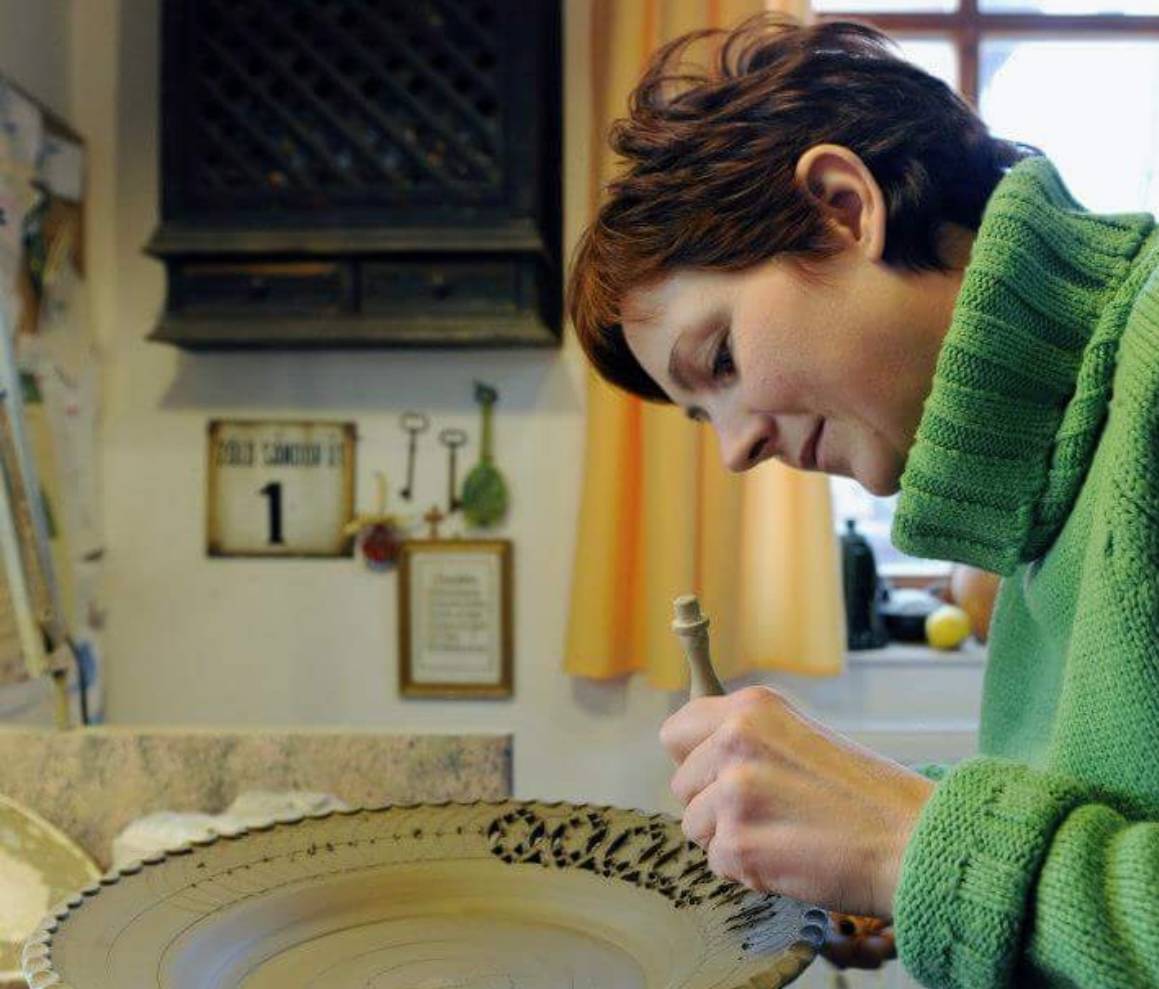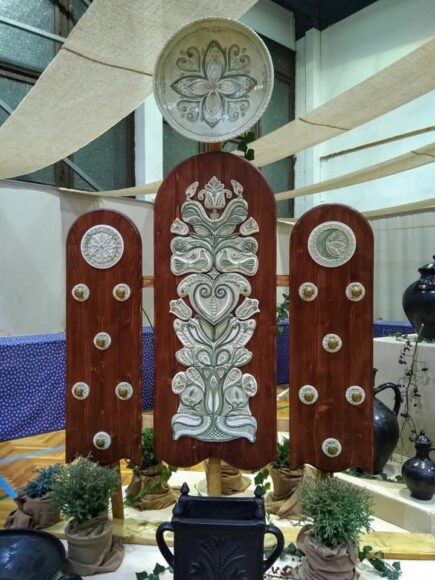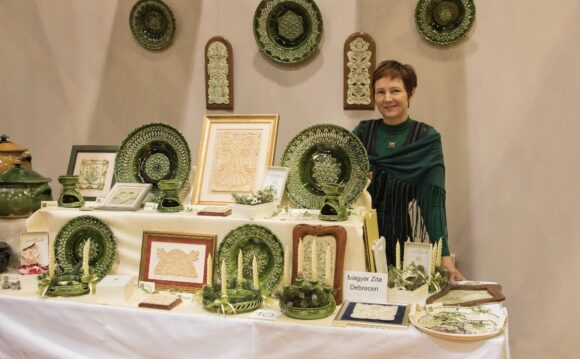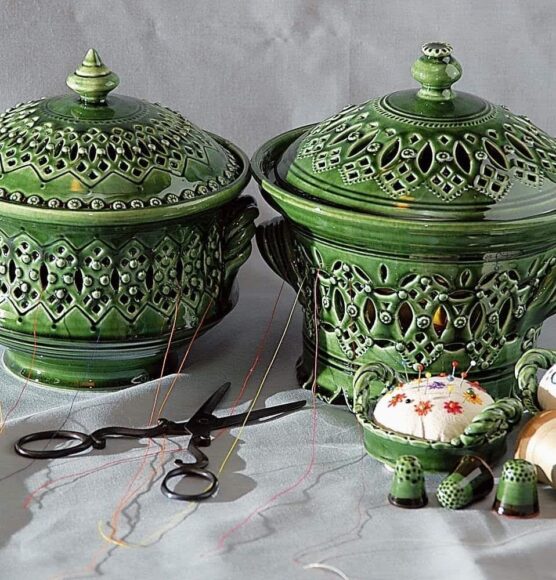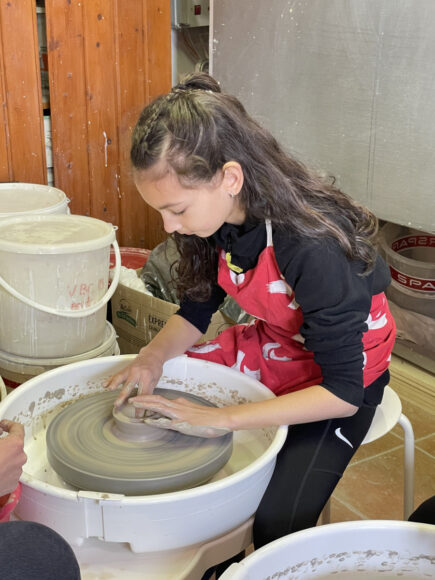In our column entitled “Thrive in Debrecen”, we speak to people who live and work among us, many of us may know them personally, or at least have heard of them. They honestly tell about themselves, their lives, and how to make a living and prevail in the city of Cívis. This time, we looked into the life of Zita Magyar, a folk craftsman from Debrecen, the creator of Kerámiakuckó.
How did you get involved with pottery?
As a child, I was greatly influenced by Margit Kovács, whose work I still love to this day. It was because of him that I decided that I wanted to become a ceramicist as well. Later, after graduation, I obtained the potter’s certificate, from then on I consider the Hungarian folk tradition as a starting point. The proportions of Hungarian folk pottery amaze me, I consider the triple unity of function-form-decoration as an example to be followed. In the first years, I tried to copy museum artifacts, mainly openwork, green-glazed ceramics and vessels with blue buttermilk on a white background from Barcaság were close to me.
I learned a lot from this, and after a while I already shaped the dishes in my own image. After three years of continuous judging, I applied for the title of folk artist, which I received in 1998. There is a wide range of pottery and ceramic works in Hungary. When they ask me what I do, I usually answer that my disk-shaped dishes are either appliqued, openwork, or inlaid, and a little Art Nouveau influence can be found on them, because I am in love with this era. For a few years, I have been making more and more pictures and sculptures, including medals and coats of arms. It is important that the objects have a message and that they can see that they are the work of Hungarian artists. The point is not the category, but the creative, unique way of seeing.
How long has the Kerámiakuckó been around?
Six years ago, the idea came – actually under the influence of some acquaintances – to welcome people interested in pottery to the workshop. The goal was free creation from the very beginning, and this has not changed today. Here, everyone creates as they please and moves at their own pace. I “just” give ideas and show you how to do a job and help you with it. Mix the paint and the glaze, roll them into a disk, ring them, and turn them. It is important that visitors to the booth feel good while creating. But I must admit, when I created the Keramiakucko on Facebook, I was quite worried about how the reception would be.
Did you realize then that it was going to be real?
Yes, because I got a separate workplace. The same workshop gave place to my work, my orders and the people who came to me to study and relax. But the system is very well established. On Wednesdays, I lead a professional class for adults, and on two Saturdays a month, anyone who wants to create can sign up for two suitable sessions for 2×3 hours.
What age group do you belong to?
The minimum age limit for weekend two-time classes is six years. For the first time, we molded clay and made a disk. The second time, we paint and glaze the object that has already been fired, which will then be fired again, and only then can it be taken away. If they come for the second time, they greet each other as acquaintances. Around Christmas, we also hold a year-end meeting with board games and discussions with the professionals. It is also not uncommon for siblings or mother and daughter to come together as a family program, but the Kerámiakuckó has also been the venue for team-building training and birthday parties.
Is this your full-time job?
Yes, it always has been. Thank God I always had enough work to not look for anything else. Independence is important to me. I also participate in the work of the Bihari Folk Art Association and the Handicraft Foundation.
What is worth knowing about the association and the foundation? What tasks do you perform in it?
Our association, which is thirty years old this year, currently has a membership of more than one hundred and fifty people from more than twenty settlements. The creators came mainly from Berettyóújfalu and other small towns in Bihar, but we also have members from Debrecen, Albertirsa, Budapest and Transylvania. The creators practice eighteen types of crafts, and the association aims to revive, preserve and perpetuate the folk culture, craft traditions, and spiritual and material memories of the Bihar region. In addition, to provides the masters with the opportunity to introduce themselves at exhibitions and presentations in Berettyóújfalu, Hajdú Bihar county and throughout Hungary.
The Bihari Folk Art Association has been a member of the Association of Folk Art Associations since its establishment. In this way, the members of our association can participate in the national events, presentations and exhibitions of the NESZ. Our creators not only learn but also teach. Our masters pass on their knowledge to interested adults and the younger generations. We organize exhibitions all over the country, and every two years we organize the national competition and conference called “We will put out the filter”, in which I participate in organizing and organizing the exhibition. During the more than thirty years of its existence, the Handicraft Foundation has successfully served and helped to introduce and pass down the Hungarian, Tiszántúl, and Debrecen craft traditions among young people.
Among other things, in cooperation with co-organizers, he made the National Youth Folk Crafts Competition, the National Exhibition of Young Craftsmen and the related Wandering Bachelor Conference a traditional national event for young people aged 16-25. He delivered the catalogs containing award-winning works to thousands of young people. He was the initiator and co-organizer for more than twenty years of the Christmas craft festival and fair held in the building of the mayor’s office in Debrecen. At these events, more than forty artisans and folk artists presented their work, and about three thousand visitors participated. My main task is to participate in the organizational work, writing applications and running the programs.
Are today’s youth open to being passed down?
We have young people who recently graduated from the Nádudvar People’s Handicraft Vocational School and became our members. They are very dedicated, and we hope that our association will be able to continuously help them to stick to their chosen profession.
Every creator is a little different. How are you different from other folk artists?
Each person has a different personality and values different things, so they create in a different style. A lot of people are already getting to know the objects I made, and that’s a great feeling because it means there’s something unique about it. When I observe other people’s work, I also appreciate uniqueness, creativity, and something inexplicable.
Can you make a living from this? Can you make a living from this in Debrecen?
With a lot of work, yes. Now that many more people know me, it’s easier for me to sell my work. But he has thirty years of experience behind him.
It cannot be said that what you have created is uniform.
It isn’t, because there are always challenges, no two days and no two subjects are the same. I do my work by hand or on a disc, and I also like plastic tasks. For example, this is the seventh year that I have made the medals for the 3×3 basketball, and the third year for the 5×5 world championship. This is a cool job because I get to design the design as well.
What experiences and extras does pottery give to those who come and try it?
Total relaxation. Realizing your ideas, trying out new techniques, and tools, and getting to know other people. Strong concentration to work accurately and skillfully on their work. A kind of connection with a natural material, the clay itself. It’s a new feeling for people because they are disconnected from the computer world. Although they are a little timid the first time, after a few sessions they are already surprised when they see the objects they have made, that it was made by them. It is also a great pleasure for me to see their happiness at this time.
If you can get by in Debrecen, do you consider yourself a happy person?
Yes. Even if these are moments, I consciously pay attention to making as many of them as possible for me and those around me. Of course, the milieu we create also adds to this, which protects us almost like a shell. Anyone who comes to me thinks that it is easy here, that you can only live happily here. But this is always the case because we must consciously take care to find balance in this strange world. It is also important for me to be surrounded by a lot of beauty, such as flowers, a nice piece of furniture, or a ceramic object.
How did you become a different person when you chose this artistic trend that you represent?
For me, creating with clay is like breathing and is completely natural to me. I don’t even know what it would be like without him. This is how I express myself, and it is much easier than expressing myself verbally. This world gives harmony and security. And from the feedback, I can see that I bring joy to others with my work. As the years go by, we clean up, calm down and look at things in the world differently, different things become important than in our younger years. I was a maximalist, strict with myself, but now I have slowed down, I can feel exactly where I need to focus my energy. I like to relax and make my world even more beautiful and homely because I think that’s what we all should be most aware of.
Translated from Judyt Rontó’s article on the Debreceni Nap page.









